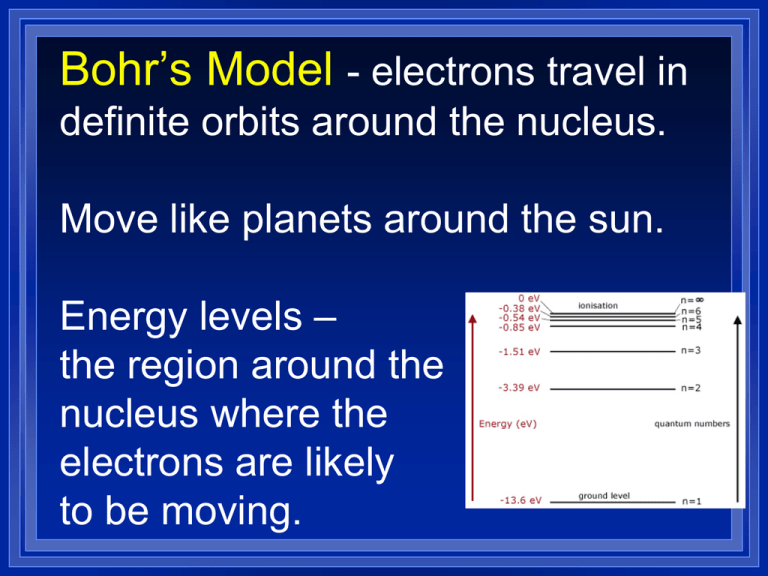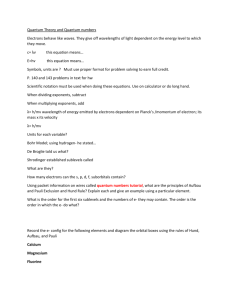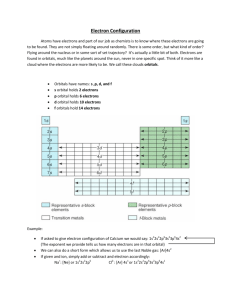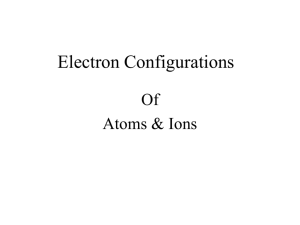Energy level
advertisement

Bohr’s Model - electrons travel in definite orbits around the nucleus. Move like planets around the sun. Energy levels – the region around the nucleus where the electrons are likely to be moving. Bohr’s model Energy level of an electron • analogous to the rungs of a ladder The electron cannot exist between energy levels, just like you can’t stand between rungs on a ladder A quantum of energy is the amount of energy required to move an electron from one energy level to another The Quantum Mechanical Model Comes from the math equations Erwin Schrodinger derived. Based on probability and Heisenberg uncertainty principle. Atomic Orbitals Principal Quantum Number (n) = the energy level of the electron: 1, 2, 3, etc. Within each energy level, the complex math of Schrodinger’s equation describes several shapes. These are called atomic orbitals (coined by scientists in 1932) - regions where there is a high probability of finding an electron. Sublevels- like theater seats arranged in sections: letters s, p, d, and f Principal Quantum Number Generally symbolized by “n”, it denotes the shell (energy level) in which the electron is located. Maximum number of electrons that can fit in an energy level is: 2n2 How many e- in level 2? 3? Summary # of shapes (orbitals) Maximum electrons Starts at energy level s 1 2 1 p 3 2 d 5 6 10 f 7 14 4 3 Increasing energy 7s 6s 5s 7p 6p 5p 4p 4s 6d 5d 4d 5f 4f 3d 3p 3s 2p 2s aufbau diagram 1s Aufbau is German for “building up” Electron Configurations… …are the way electrons are arranged in various orbitals around the nuclei of atoms. Three rules tell us how: 1) Aufbau principle - electrons enter the lowest energy first. 2) Pauli Exclusion Principle - at most 2 electrons per orbital - different spins Pauli Exclusion Principle No two electrons in an atom can have the same four quantum numbers. Wolfgang Pauli To show the different direction of spin, a pair in the same orbital is written as: Electron Configurations 3) Hund’s Rule- When electrons occupy orbitals of equal energy, they don’t pair up until they have to. Let’s write the electron configuration for Phosphorus We need to account for all 15 electrons in phosphorus Increasing energy 7s 6s 5s 7p 6p 6d 5d 5p 4d 4p 3s 2s 1s 4f 3d 4s 3p 5f The first two electrons go into the 1s orbital 2p Notice the opposite direction of the spins only 13 more to go... Increasing energy 7s 6s 5s 7p 6p 6d 5d 5p 4d 4p 5f 4f 3d 4s 3p 3s 2p 2s 1s The next electrons go into the 2s orbital only 11 more... Increasing energy 7s 6s 5s 7p 6p 5p 4p 4s 6d 5d 4d 5f 4f 3d 3p 3s 2p 2s 1s • The next electrons go into the 2p orbital • only 5 more... Increasing energy 7s 6s 5s 7p 6p 5p 4p 4s 6d 5d 4d 5f 4f 3d 3p 3s 2p 2s 1s • The next electrons go into the 3s orbital • only 3 more... Increasing energy 7s 6s 5s 4s 3s 2s 1s 7p 6p 5p 4p 6d 5d 4d 5f 4f 3d 3p • The last three electrons go into the 3p orbitals. 2p They each go into separate shapes (Hund’s) • 3 unpaired electrons Orbital notation = 1s22s22p63s23p3







